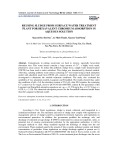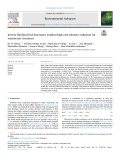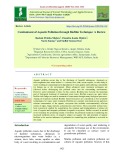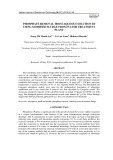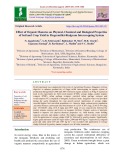
Sludge of water treatment
-
Part 1 of ebook "Wetlands for water pollution control (Second edition)" includes the following main contents: Chapter 1 - Water quality standards; Chapter 2 - Water treatment; Chapter 3 - Sewage treatment; Chapter 4 - Stream pollution and effluent standards; Chapter 5 - Preliminary treatment; Chapter 6 - Primary treatment; Chapter 7 - Coagulation and flocculation; Chapter 8 - Sludge blanket clarifiers; Chapter 9 - Flotation systems; Chapter 10 - Slow filtration;...
 253p
253p  khuynhlinhnguyet1009
khuynhlinhnguyet1009
 05-04-2024
05-04-2024
 9
9
 1
1
 Download
Download
-
Ebook "Green technologies for wastewater treatment: Energy recovery and emerging compounds removal" evaluates water management together with energy use. The strong effects that the release of emerging pollutants such as endocrine disruptors (EDCs), pharmaceuticals and personal care products (PPCPs) have in wastewater reuse applications are examined, as well as the need to optimize the energy consumption in wastewater treatment.
 105p
105p  nhanphanguyet
nhanphanguyet
 28-01-2024
28-01-2024
 9
9
 2
2
 Download
Download
-
Contaminants in plating wastewater are hard to remove, especially hexavalent chromium ions. This waste stream contains a large amount of Cr6+, a highly toxic metal, potential to cause cancer. To reduce this pollution, sludge from a supply water treatment plant (DWTS) has been used to make adsorbent.
 13p
13p  viannee
viannee
 02-08-2023
02-08-2023
 3
3
 3
3
 Download
Download
-
Part 1 of ebook "Current trends in civil engineering: Select proceedings of ICRACE 2020" has presents the following content: treatment of well water contaminated with septic tank effluent using a modified compacted sand filter; heavy metal fractionation in aerobic and anaerobic sewage sludge; environmental remediation of oil contaminated soil; treatment and reuse of periyar sedimented soil using nanochemicals;...
 107p
107p  dieptieuung
dieptieuung
 20-07-2023
20-07-2023
 7
7
 3
3
 Download
Download
-
Ebook Endocrine disrupters in wastewater and sludge treatment processes: Part 2 presents the following chapters: Chapter 5: Fate and behavior of endocrine disrupters in sludge treatment and disposal, Chapter 6: Endocrine disrupters in receiving waters, Chapter 7: Endocrine disrupters in drinking water and water reuse, Chapter 8: Management strategies for endocrine disrupters in the aquatic environment.
 151p
151p  runthenight08
runthenight08
 12-04-2023
12-04-2023
 5
5
 1
1
 Download
Download
-
In this study, a composite material (ACS) was successfully synthesized from activated carbon (AC) derived from soybean curd and sludge from the supply water treatment process using FeCl3. Subsequently, the ACS was employed as a heterogeneous catalyst for the degradation of Paracetamol (PRC) in solutions under conditions of the Fenton process.
 9p
9p  vicedric
vicedric
 08-02-2023
08-02-2023
 6
6
 1
1
 Download
Download
-
This study evaluated the performance of a laboratory-scale inverse fluidised bed reactor (IFBR) for biological selenate reduction at 30◦C. The IFBR with floating biomass carriers was fed with synthetic mine water (pH 6.0–7.0) containing ~10 mM (1.4 g L− 1 ) selenate, nutrients and 10 mM ethanol as electron donor and inoculated with selenate reducers enriched from anaerobic sludge and environmental samples.
 7p
7p  thebadguys
thebadguys
 15-01-2022
15-01-2022
 12
12
 2
2
 Download
Download
-
n developing countries, industrialization is the main cause of water pollution because of the various industries which generate wastewater that is needed to be discharged. The availability of fresh clean water is becoming increasingly limited in many areas of the world resulting in scarcity of potable water in many regions around the globe. The membranes have emerged as an efficient compact technology for municipal and industrial wastewater treatment.
 17p
17p  nguathienthan8
nguathienthan8
 20-10-2020
20-10-2020
 23
23
 1
1
 Download
Download
-
Aquatic pollution occurs due to the discharge of harmful substances, chemicals or microorganisms into water bodies i.e. a stream, river, lake, ocean, aquifer, or other body of water resulting in contamination & degradation of water quality and rendering it unsuitable for human use or the environment. Many advanced water treatment techniques are followed before discharging this polluted water into the surrounding environment. However some limitations is there. In this context, Biofilms have become the important part of biological treatment of municipal waste water.
 13p
13p  angicungduoc6
angicungduoc6
 22-07-2020
22-07-2020
 17
17
 1
1
 Download
Download
-
The purpose of this study was to modify the sludge from DWTP as a low-cost adsorbent for adsorption of phosphate in wastewater. The absorption performance of MS was examined, and the removal mechanisms were elucidated. The finding of this study is helpful for further development of a low-cost adsorbent based on sludge from DWTP to remove P in wastewater and offers a solution reduce water treatment sludge production and disposal fees also.
 7p
7p  abcxyz123_02
abcxyz123_02
 03-03-2020
03-03-2020
 22
22
 0
0
 Download
Download
-
Petroleum oil sludge resulting from crude oil storage, illegal crude oil refining and bunkering activities constitutes environmental hazards and pollution in the crude oil producing communities in the Niger Delta region of Nigeria. Biostimulation with N.P.K. fertilizer option C, bioargumentation with indigenous hydrocarbon utilizing bacteria (HUB) option B, combination of biostimulation and bioaugmentation as option A and option D was without any bioremediation treatment were employed in the bioremediation of brackish water artificially polluted with petroleum oil sludge.
 28p
28p  caygaocaolon2
caygaocaolon2
 11-03-2020
11-03-2020
 18
18
 2
2
 Download
Download
-
Field experiment was conducted at University of Agricultural Sciences, Bangalore with an objective to enhance productivity of finger millet intercropping in organic system of production during Kharif 2006 and 2007. Different organic manures at 50 kg N equivalent used in the experiment are Farm yard manure (FYM), sewage sludge, poultry manure compost (PMC), urban garbage compost, enriched urban garbage compost and vermicompost (VC) compared to inorganic fertilizers alone. Irrigation water was provided during dry spells throughout the crop growth period.
 9p
9p  nguathienthan2
nguathienthan2
 19-12-2019
19-12-2019
 26
26
 0
0
 Download
Download
-
The presence of chlorine in alternative fuels (e.g., sewage sludge, municipal solid waste or incineration ash, chlorinated biomass,) has both direct and indirect implications on cement kiln emissions and performance. Methods have been developed to properly manage chlorine and its potential implications – but it is important that these implications be recognized and managed. Trace levels of chlorine in feed materials can lead to the formation of acidic gases such as hydrogen chloride (HCl) and hydrogen fluoride (HF) (WBCSD 2002).
 0p
0p  loixinloi
loixinloi
 08-05-2013
08-05-2013
 62
62
 5
5
 Download
Download
-
Sewage sludge as an uncalled for product of wastewater treatment poses the challenge to society of disposing of it, but at the same time gives us the opportunity of beneficial use by closing the cycle of nutrients: sludge derived from agricultural activity must return to soil if a sustainable and ecologically sound management of these materials is desirable (SEQUI et al. 2000). At present the major ways of disposing of sewage sludges are deposition, landfill and incineration, only part of the sludges are used in agriculture. ...
 30p
30p  ut_hai_can
ut_hai_can
 29-12-2012
29-12-2012
 72
72
 9
9
 Download
Download
-
The objective of waste water treatment is to prevent large quantities of substances to reach and impact the environment in high doses and concentrations. Areas of high population densitiy naturally are areas were production of sewage sludge is high (see Figure 1-1). Presently about 8 million t of sewage sludges (MAGOAROU 2000) are produced each year in the EU member states (Table 1-1). Its high content of organic materials, of nitrogen and phosphorous suggest their use as soil conditioner and fertilizer in agriculture.
 0p
0p  ut_hai_can
ut_hai_can
 29-12-2012
29-12-2012
 58
58
 6
6
 Download
Download
-
VNU Journal of Science, Natural Sciences and Technology 24 (2008) 280-286 In this study, primarily treating waste sludge rich of Cr, Ni, Fe,…generated from electroplating wastewater treatment plant and experimentally methods of utilizing wastes as inorganic pigment in production of bricks were carried out. Economic, technical and environmental efficiency and feasibility, bases to apply to practical conditions were evaluated. The results show that water accounts for about 70% of sludge. Contents of Ni, Cr and Fe are relatively high (20, 4.5 and 2.5%, respectively). ...
 7p
7p  tuanlocmuido
tuanlocmuido
 13-12-2012
13-12-2012
 68
68
 8
8
 Download
Download
-
Pot and field trials were carried out using sediment dredged from the port of Bremen (Germany) and deposited in a settling basin near Bremen; the sediment is polluted with Cd and Zn. Five iron-bearing materials were added to the soil (1% pure Fe in soil dry matter) to immobilize the heavy metals: ‘Red mud from the aluminium industry, sludge from drinking-water treatment, bog iron ore, unused steel shot and steel shot waste.
 8p
8p  tudoia
tudoia
 06-04-2011
06-04-2011
 115
115
 6
6
 Download
Download
CHỦ ĐỀ BẠN MUỐN TÌM










